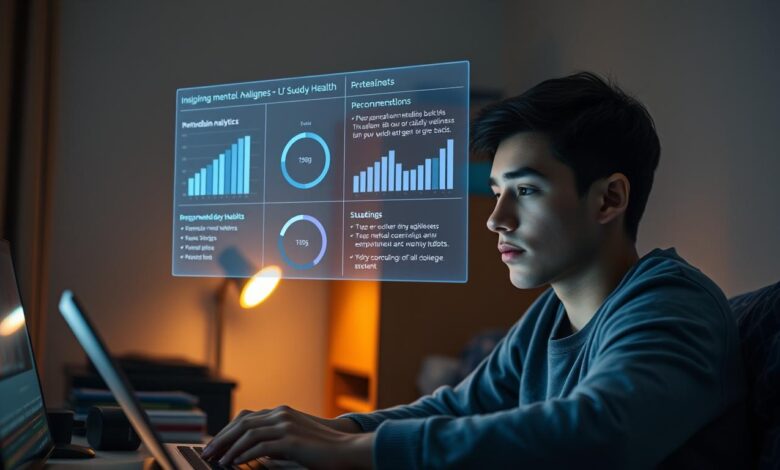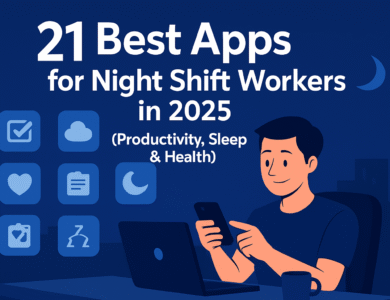
Many students find it hard to keep their mental well-being while working night shifts. They face a big challenge balancing school work with odd hours. This can cause a lot of stress and worry.
Using AI to help these students is getting more important. AI tools can offer tailored support to help them handle their mental health better.
This article will look into how AI can aid students working night shifts. We’ll see the good things AI can do for their AI for night shift student mental health. It will give a full view of AI’s benefits and uses in this area.
The Unique AI for night shift student mental health
Night shift students face many mental health challenges. These can affect their well-being and daily life. The irregular schedules can harm their school work and personal life.
Sleep Disruption and Circadian Rhythm Disturbances
One big challenge is sleep disruption. Working at night and sleeping in the day messes with the body’s natural rhythm. This can lead to trouble sleeping, stress, anxiety, and depression.
Academic Performance and Cognitive Function Impacts
Irregular sleep can also hurt school work. Students might find it hard to focus, remember things, and make decisions. AI can help by managing time and keeping students on track.
Social Isolation and Relationship Strain
Night shift students often feel left out because of their schedules. This can make it hard to keep up with family and friends. Having social support is key for mental health, especially when feeling lonely.
Common Warning Signs of Mental Health Decline
It’s important to know the signs of mental health problems in night shift students. These include:
- Persistent feelings of sadness or hopelessness
- Increased irritability or mood swings
- Difficulty concentrating or making decisions
- Changes in appetite or sleep patterns
- Withdrawal from social activities
| Warning Signs | Potential Impact | Support Strategies |
|---|---|---|
| Feelings of sadness or hopelessness | Increased risk of depression | Counseling, AI-powered mood tracking |
| Difficulty concentrating | Poor academic performance | AI study assistants, cognitive training |
| Social withdrawal | Increased feelings of loneliness | Virtual support groups, social apps |
Understanding these challenges and knowing the warning signs helps night shift students protect their mental health. Using AI tools can be a big help. They offer personalized support for the unique needs of night shift work.
Implementing AI for Night Shift Student Mental Health
AI technology is changing how we support students working night shifts. It offers personalized and easy-to-access help. This can help these students deal with their unique challenges.
How AI Technology Addresses Specific Night Shift Challenges
AI tackles night shift problems like sleep issues, feeling alone, and trouble with schoolwork. For example, AI sleep trackers watch and study sleep patterns. They show how night shifts can hurt sleep quality.
Key benefits of AI in addressing night shift challenges include:
- Personalized support through data analysis
- 24/7 accessibility for immediate assistance
- Proactive interventions based on predictive analytics
Categories of AI Mental Health Support Tools
There are many AI tools for night shift students. These include:
- Virtual mental health assistants
- AI-guided cognitive behavioral therapy (CBT) tools
- Mood tracking and emotional regulation applications

Setting Realistic Expectations for AI Assistance
AI is a big help for mental health, but we must be realistic. It’s not a full replacement for human help. It’s meant to work alongside professionals.
First Steps to Incorporating AI into Your Routine
To start using AI for mental health, do the following:
- Assess your specific needs and challenges
- Explore different AI mental health tools
- Set clear goals for what you want to achieve with AI support
By taking these steps and knowing what AI can do, night shift students can use technology to better their mental health.
AI-Powered Sleep Optimization Tools
AI is key for night shift students to keep their minds sharp. It uses smart algorithms to boost sleep quality. This is vital for their mental health.
Selecting and Setting Up Smart Sleep Trackers
Choosing the right smart sleep tracker is the first step. These devices track sleep patterns and heart rate. Look for accuracy, comfort, and device compatibility.

Interpreting AI Sleep Analysis Reports
AI analyzes sleep data to offer insights. Reports show sleep duration and quality. It’s important to understand these to improve sleep.
Implementing AI-Recommended Sleep Schedule Adjustments
AI suggests sleep schedule tweaks based on data. These changes help align with natural rhythms. This can greatly improve sleep and well-being.
Combining Sleep Tech with Environmental Modifications
Using AI trackers and adjusting the sleep environment also helps. Try blackout curtains, white noise, or cooler rooms. These changes, along with AI tweaks, can greatly enhance sleep.
| Sleep Improvement Strategy | Description | Benefit |
|---|---|---|
| AI Sleep Tracking | Monitors sleep patterns and provides insights | Personalized sleep data |
| Environmental Modifications | Adjusts sleep environment for optimal conditions | Improved sleep quality |
| Schedule Adjustments | AI-recommended changes to sleep schedule | Better alignment with circadian rhythms |
By using AI tools and making environmental changes, night shift students can greatly improve their sleep. This boosts their mental health.
Leveraging Virtual Mental Health Assistants and Chatbots
Night shift students can now get help from AI-powered virtual mental health assistants anytime. These tools are made to give quick help. They help students deal with the mental health issues that come with non-traditional work hours.
Setting Up 24/7 Emotional Support Systems
To set up a virtual mental health assistant for 24/7 support, pick a platform with AI chatbots. These systems can give coping strategies, emotional support, and resources for more help.
For example, a student feeling anxious during a late-night study can talk to a chatbot. The chatbot can offer quick tips on how to relax. “This instant support can be a game-changer for students who are isolated during night shifts,” says Dr. Jane Smith, a mental health expert.
Using AI-Guided Cognitive Behavioral Therapy Exercises
Many virtual mental health assistants use AI-guided CBT exercises. These exercises help students change negative thought patterns. They learn to cope better.
- Identify distorted or unhelpful thinking patterns
- Learn to reframe negative thoughts
- Develop problem-solving skills
Configuring Crisis Intervention Features
For students in mental health crises, setting up crisis intervention features is key. This means adding emergency contact info and making sure the virtual assistant can spot and handle crisis situations.
| Feature | Description | Benefit |
|---|---|---|
| Emergency Contact Info | Stores critical contact details | Quick access during crises |
| Crisis Detection | AI-driven detection of crisis situations | Immediate response to emergencies |
Creating Healthy Boundaries with Virtual Assistants
Virtual mental health assistants are very helpful, but setting boundaries is important. Students should make sure to balance tech use with real-life interactions.
“While technology can provide support, it’s also important to nurture human connections,” says Dr. John Doe, emphasizing the need for balance.

By knowing how to use virtual mental health assistants and chatbots well, night shift students can improve their mental health. These tools, used right, are a great addition to traditional mental health support.
Mastering AI Mood Tracking for Emotional Regulation
AI mood tracking is changing how night shift students handle their emotional health. It uses advanced algorithms and machine learning. This gives students personalized insights into their emotional patterns, helping them manage their feelings better.
Establishing Consistent Mood Logging Practices
To make the most of AI mood tracking, it’s important to log your mood regularly. You can do this through mobile apps or wearable devices. Consistency is key for the AI to understand your emotional patterns over time.
Responding to AI-Generated Coping Recommendations
AI mood tracking systems do more than just track your mood. They also offer personalized coping strategies based on your input. By following these recommendations, students can find healthier ways to deal with stress and negative emotions from night shifts.

Identifying Patterns Between Night Shifts and Mood Changes
AI mood tracking is great at finding patterns between night shifts and mood changes. By analyzing this data, students can get ready for tough emotional times.
Sharing AI Insights with Healthcare Providers
Sharing AI mood tracking insights with healthcare providers can also help. It leads to better discussions about mental health and more effective treatments. Collaboration between AI insights and professional healthcare can greatly improve emotional regulation.
By mastering AI mood tracking, night shift students can take charge of their emotional well-being. This leads to better mental health and resilience.
Optimizing Academic Performance with AI Study Assistants
AI study assistants are changing how students work at night. They use smart algorithms to help students manage their schoolwork better.
Creating AI-Optimized Study Schedules Around Shifts
AI study assistants make study plans that fit a student’s night shift schedule. They figure out when the student learns best. This way, studying is more effective.
Dr. Jane Smith, an expert in education tech, says, “AI study planners adjust to a student’s changing schedule. They offer flexible and personalized learning.”
“The future of learning is not just about accessing information, but about accessing the right information at the right time.”
Dr. Jane Smith
Utilizing Cognitive Enhancement Applications
Cognitive apps are part of AI study assistants. They use brain training exercises and focus-enhancing games to boost brain power. This is especially helpful at night when students might feel tired.
Implementing Focus and Productivity Tools During Night Hours
AI tools help students stay focused at night. They block distractions, remind students of tasks, and show how well they’re studying. This keeps students on track.
Measuring and Adjusting Based on Performance Metrics
AI study assistants track how well students are doing. This helps students see what they need to work on. They can then change their study plans to do better.
Using AI study assistants can really help night shift students do better in school. As education changes, using AI tools will be key for students to learn well.
Building Your Personalized AI Mental Health Ecosystem
A well-designed AI mental health ecosystem offers night shift students a robust support system for their mental health needs. It integrates various AI tools and technologies to provide comprehensive support.
Assessing Your Specific Mental Health Needs
The first step is to assess your specific mental health needs. Identify challenges like sleep disruption, social isolation, or academic stress. AI-powered assessment tools can help you understand your mental health landscape and pinpoint areas that require attention.
Selecting Compatible AI Tools for Maximum Benefit
After assessing your needs, select AI tools that fit your requirements. This could include AI-powered sleep optimization tools, virtual mental health assistants, or mood tracking applications. It’s essential to choose tools that integrate well with each other to create a seamless ecosystem.
Creating Automated Workflows Between Applications
To maximize the benefits of your AI mental health ecosystem, create automated workflows between applications. For instance, your sleep tracking data can inform your mood tracking app, providing a more holistic view of your mental health. Automation helps in reducing manual effort and ensures that your ecosystem is dynamic and responsive.
Regularly Evaluating and Refining Your AI Support System
Regular evaluation and refinement of your AI support system are crucial to its effectiveness. This involves periodically reviewing the data collected by your AI tools, assessing their impact on your mental health, and making necessary adjustments. Continuous refinement ensures that your AI mental health ecosystem remains aligned with your evolving needs.
Navigating Limitations and Ethical Considerations
As we rely more on AI for mental health, we must face its limits and ethics. AI has helped night shift students a lot. But, we need to think about its use carefully.
Protecting Your Privacy and Mental Health Data
Using AI for mental health raises big privacy concerns. To keep your data safe, do the following:
- Check the privacy policies of AI tools to know how your data is handled.
- Use strong, unique passwords and two-factor authentication for AI accounts.
- Be careful about sharing personal info with AI chatbots or virtual assistants.
Data encryption and secure servers are key when picking AI mental health tools. Make sure they follow data protection laws like HIPAA in the U.S.
Recognizing When AI Support Is Insufficient
AI is helpful but has its limits. If you face:
- Severe mental health issues, like suicidal thoughts or deep depression
- Urgent crisis situations
- Complex mental health problems AI can’t handle
Seek help from human professionals or emergency services. AI can’t replace human judgment and skill in serious cases.
Balancing Technology Use with Human Connection
It’s important to balance tech use with human interaction for our well-being. Here’s how:
- Make time for regular talks with friends, family, or mental health experts.
- Do things that help you meet people face-to-face, like joining clubs or support groups.
- Use AI tools wisely to enhance, not replace, human connections.
Warning Signs That Indicate Need for Professional Intervention
Watch out for these signs that mean you need professional help:
- Big changes in mood, behavior, or sleep
- Feeling hopeless or despairing
- Talking about or planning self-harm or suicide
If you or someone you know shows these signs, get help from a qualified mental health professional or a crisis hotline.
Conclusion: Embracing the Future of AI-Supported Night Shift Wellness
AI technology is changing how night shift students handle mental health. It helps with sleep, emotions, and school work. This is a big help for those working or studying at odd hours.
AI is becoming key in mental health support. As it gets better, we’ll see tools that really understand and help each person. This is a big step forward.
AI wellness is a way for night shift students to care for their minds. We need to keep making these tools better and easier to use. This is crucial for their well-being.
AI has a huge role in improving night shift students’ mental health. By improving these technologies, we can make their lives better. This will help everyone who works or studies when most people are asleep.
FAQ
What is AI for night shift student mental health?
AI for night shift student mental health uses artificial intelligence to help students who work nights. It offers tools to manage sleep, school work, and feeling lonely.
How can AI help night shift students with sleep disruptions?
AI tools track sleep patterns and give tips to improve sleep. They also help adjust sleep schedules for better rest.
What are virtual mental health assistants and chatbots?
Virtual mental health assistants and chatbots are AI tools. They offer 24/7 support, help with therapy, and handle crises. They help night shift students with their mental health.
How can AI mood tracking help with emotional regulation?
AI mood tracking logs and analyzes emotions. It finds patterns and suggests ways to cope. This helps night shift students manage their feelings better.
What are AI study assistants, and how can they help night shift students?
AI study assistants help plan study times and use apps to improve focus. They help night shift students do better in school.
How can I build a personalized AI mental health ecosystem?
To create a personalized AI mental health system, first figure out what you need. Then pick AI tools that fit. Set up workflows and keep improving your system.
What are the limitations and ethical considerations of using AI for mental health?
Using AI for mental health has limits and ethics. It’s important to keep your data safe and know when AI isn’t enough. Also, don’t forget the value of human connection.
How can I protect my privacy and mental health data when using AI tools?
To keep your data safe, check the privacy policies of AI tools. Know how your data is used. Take steps to protect your personal info.
When should I seek professional help instead of relying on AI support?
If you’re dealing with serious mental health issues, need more help than AI offers, or can’t manage on your own, get professional help.



